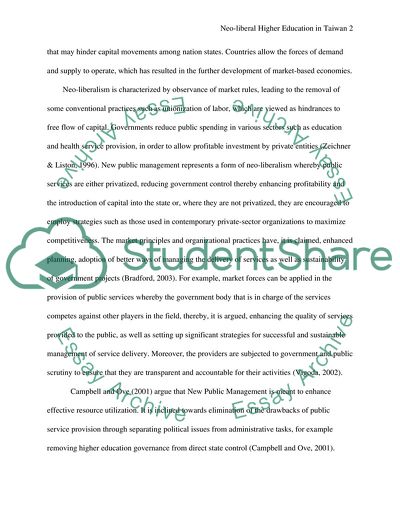Cite this document
(“Neo-liberal Higher Education in Taiwan - How global neo-liberal Assignment”, n.d.)
Neo-liberal Higher Education in Taiwan - How global neo-liberal Assignment. Retrieved from https://studentshare.org/miscellaneous/1566902-neo-liberal-higher-education-in-taiwan-how-global-neo-liberal-ideology-is-changing-taiwanese-higher-education-and-the-possible-future-of-taiwanese-higher-education-under-the-influence-of-market-economics
Neo-liberal Higher Education in Taiwan - How global neo-liberal Assignment. Retrieved from https://studentshare.org/miscellaneous/1566902-neo-liberal-higher-education-in-taiwan-how-global-neo-liberal-ideology-is-changing-taiwanese-higher-education-and-the-possible-future-of-taiwanese-higher-education-under-the-influence-of-market-economics
(Neo-Liberal Higher Education in Taiwan - How Global Neo-Liberal Assignment)
Neo-Liberal Higher Education in Taiwan - How Global Neo-Liberal Assignment. https://studentshare.org/miscellaneous/1566902-neo-liberal-higher-education-in-taiwan-how-global-neo-liberal-ideology-is-changing-taiwanese-higher-education-and-the-possible-future-of-taiwanese-higher-education-under-the-influence-of-market-economics.
Neo-Liberal Higher Education in Taiwan - How Global Neo-Liberal Assignment. https://studentshare.org/miscellaneous/1566902-neo-liberal-higher-education-in-taiwan-how-global-neo-liberal-ideology-is-changing-taiwanese-higher-education-and-the-possible-future-of-taiwanese-higher-education-under-the-influence-of-market-economics.
“Neo-Liberal Higher Education in Taiwan - How Global Neo-Liberal Assignment”, n.d. https://studentshare.org/miscellaneous/1566902-neo-liberal-higher-education-in-taiwan-how-global-neo-liberal-ideology-is-changing-taiwanese-higher-education-and-the-possible-future-of-taiwanese-higher-education-under-the-influence-of-market-economics.


